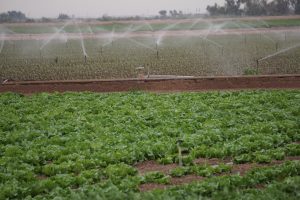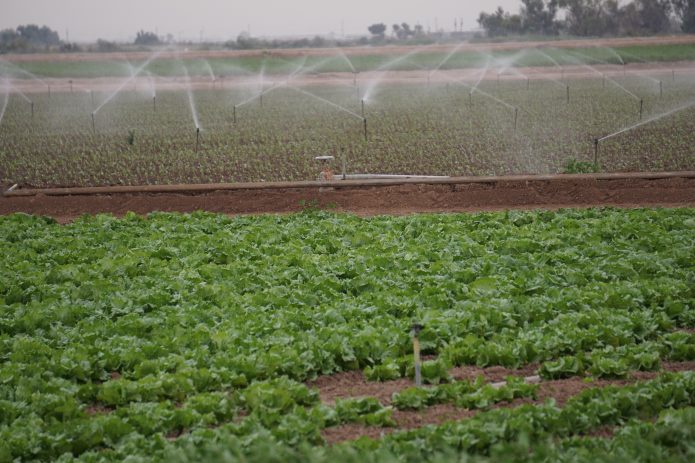
A farm field in the Imperial Valley is irrigated with sprinklers in December 2017. Sprinkler irrigation is one of the on-farm conservation measures farmers are implementing as part of the Water Transfer Agreement between the Imperial Irrigation District and the San Diego County Water Authority. The conservation program, funded by the Water Authority and implemented by IID and local farmers, is crucial to the success of the Quantification Settlement Agreement. In 2018 all conservation under the QSA and water transfer will be done through on-farm and system conservation methods.
In ringing in a new year, there is much to discuss in the world of water, specifically when it comes to the Colorado River, the Quantification Settlement Agreement (QSA), and the Water Transfer Agreement between the Water Authority and the Imperial Irrigation District. This year, 2018, brings with it critical milestones that deserve some discussion as we launch into what will ultimately be an important period in the story of water.
As most who read this blog probably already know, the Water Transfer Agreement between the Water Authority and IID is a 45-to-75-year agreement for the transfer of up to 200,000 acre-feet of conserved water from Imperial Valley to the San Diego region. The transfer has been implemented since 2003, when the QSA was signed, and since then it has been a slow ramp-up period in both the conservation program and transfer. For the last five years, the amount of water transferred to San Diego has hovered at 100,000 acre-feet per year. This year brings change as the transfer will increase to 130,000 acre-feet, and will continue to ramp up toward the goal of 200,000 acre-feet per year by 2021. That, in and of itself, is one important milestone.
However, a second component of the change ushered in this year is that the 15-year fallowing program ended as of Dec. 31, 2017. For 15 years, Imperial Valley farmers have taken part in a volunteer fallowing program designed to both conserve water while more permanent on-farm and system conservation programs were developed and implemented to provide mitigation water to the Salton Sea. So, as we move into this second milestone where fallowing will no longer be a means of conservation, all transfer water will strictly come from on-farm and system conservation with funding from the Water Authority to cover those costs. Farmers in the Valley have already proven they can conserve well over 100,000 acre-feet per year as over the last two years farmers have conserved well above that mark, which has enabled IID to store extra conserved water in Lake Mead and with MWD for future use
As we discuss the end of fallowing, that leads to a third critical milestone … the end of mitigation water flows to the Salton Sea. This is a milestone that has received much media coverage and has generated concerns largely due to the expectation that the State would—come 2018—be well into a restoration program. Remember, QSA legislation adopted in 2003 established that restoration would be a State responsibility and the idea was that a restoration program would be underway by this year. The State has begun a restoration program, but the process has been slow and the State is not as far along as most would like.
Independent from the State’s restoration effort, for 15 years, the Water Authority, IID and the Coachella Valley Water District have all funded mitigation water to the Salton Sea as members of the QSA Joint Powers Authority (JPA). The three water agencies, through legislation, were tasked with spending what in real dollars will be $288 million on a mitigation program, and the State—also a member of the JPA—has a responsibility to fund mitigation costs (separate from its restoration responsibility) that exceed that mark. Much of our funding has gone toward the mitigation water flows to the Sea, which were meant to maintain the salinity levels at the Sea and, as an end result, maintain the natural progression of the shoreline, which was always anticipated to recede over the last 15 years from other non-QSA related factors.
What does reaching the end of the mitigation flows mean?
The sea will face a period in which it will recede at a faster rate, and there will be more exposed playa over time—not all at once. And keep in mind, not all exposed playa will be emissive. However, the Sea will continue to have a large flow of water—as much as 750,000 acre-feet per year—generated from run-off from local waterways in the Imperial and Coachella valleys. While that does not equate to a water right for the Sea and there is no guarantee that flows will be the same each year, that is quite a bit of water to utilize to ensure the Sea continues in what officials refer to as a smaller but sustainable lake.
Moving forward, there will be two sets of actions occurring at the Sea. First, as the JPA has done from the start, it will continue to address mitigation as it relates to any effects of the QSA on the Sea. The end of mitigation water to the Sea means that the JPA will now move forward with a robust plan to monitor the playa and provide air quality projects where they will do the most good. Already, the JPA has provided 1,000 acres in pilot projects to test the most effective measures for dust control, and will now move from pilot projects to permanent projects that, again, address QSA impacts and protect local air quality.
Separately, the State as of 2018—in what is yet one more key milestone—will move forward with the implementation of its Salton Sea Management Program (SSMP), which is meant to address the overarching issue of restoration. Phase one of the SSMP is a ten-year program to address 30,000 acres of playa with habitat and air quality projects at a cost of $383 million. California voters can help that effort this year by approving a water and parks bond in June that would provide $200 million to that cause. The SSMP already received $80 million from an earlier bond, and has some additional funding available, including at least some of the $67 million in restoration funding provided by the QSA JPA (a separate piece of funding than the mitigation funding provided). There are other sources of funding also available to the SSMP, but the effort to seek State funding will have to continue annually.
It is clear 2018 represents an important year not only for the milestones occurring, but for what is to come in the years that follow as the QSA—around which all the milestones connect—continues to meet its objective of reducing California’s use of the Colorado River to its historic 4.4 million acre-foot allotment. There have been many challenges met over the first 15 years of the QSA, and there will be challenges to come, but they will be met, too. The QSA remains key to ultimately sustaining and managing operations of the Colorado River, a critical supply of water to California and all the Basin States that depend on the river.
